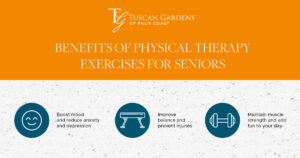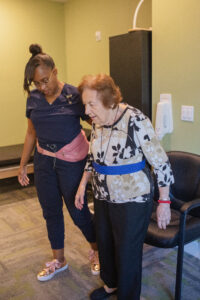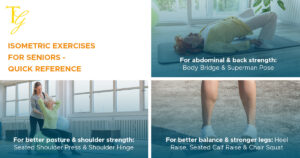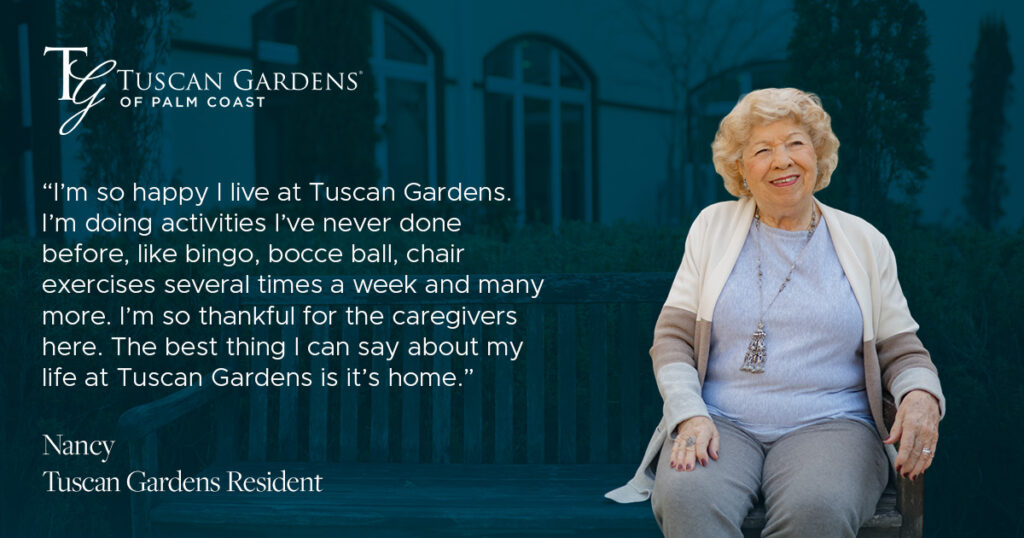The US Department of Health and Human Services encourages around 20 minutes a day of moderate exercise when possible, including exercises to strengthen muscles at least two days a week. Staying active as you get older can help boost your mood, reduce the symptoms of anxiety and depression, prevent injuries through better balance, maintain good muscle strength, and add fun to your day.
Keeping mentally and physically fit is worth working on at any age, but it can sometimes be tough to persuade your parent or loved one that exercise should be a priority. Helping them build the motivation and follow-through they need to stay active can be a great gift to your loved one throughout their life. If you’re wondering how to get your parent or loved one to do their physical therapy exercises, here are a few tips for creating a routine they can embrace.

Your loved one’s doctor or physical therapist may have provided them with exercises to do regularly, or they may have learned exercises from classes in an assisted living and memory care community like Tuscan Gardens of Palm Coast. You may also be searching for exercises for your parents or loved ones, and you have found this article.
Work with your loved one’s medical team to determine what exercises are safe for them at their current ability level. If they haven’t been active for a while or have limited mobility, it is always a good idea to start small and safe and work up to more activity.
Talk to your loved one about the exercises they’ve been asked to do; do they understand how to do them safely? Do they know why they’ve been asked to do them? Connecting with your loved one so they understand how important it is to stay active can go a long way toward creating a routine that sticks.
Turning an activity into a habit can take some work, but the main thing to remember is to make it fun. In the immortal words of Richard Simmons, “If it ain’t fun, it ain’t gonna get done!”
Make a playlist with their favorite music and make it easy for them to turn it on anytime they like to get into a groove while exercising. See if you can make the exercises into a game where each rep is a point, and they can see how their score changes as they stick with their exercise program.
There may also be exercise classes they can attend. Adding community and fun to the picture can help your loved one commit to staying active. Senior exercise classes have music, enthusiastic teachers, and a lot of fun involved, too. Consider supporting your parents or loved ones by reminding them to attend these classes and ask about them afterward; showing interest in your parents’ efforts can also help encourage them.

You can set your loved one up for success in keeping up with their exercise needs in many ways.
● Type out their exercises and place them on the dining room table, next to their favorite chair, or near wherever they like to exercise. With easy access to instructions, this visual reminder can help make exercise a habit.
● See if a reward, like a dinner at a favorite restaurant or visiting somewhere they love, can be part of keeping up their exercises.
● Print out a calendar, or help them use a habit-tracking app so your loved one can track when they’ve completed their exercises. Showing them how much progress they’ve made can motivate them to keep going.
Consider exercising with your loved one in person or on a video call. Become their accountability partner to encourage them to keep going. This can be a fun way to bond with your loved one and show them that you genuinely care about their wellbeing.

Now that you have some ideas on keeping your loved one motivated, let’s look at some isometric exercises they can try to integrate into their routine. Isometric exercises support joint and muscle health, help with balance, and can help with joint issues and osteoporosis. They are perfect for seniors looking to boost their well-being. Start with shorter durations, maybe 30 seconds per exercise, and build up to longer times as they get accustomed to the exercises.
Improve your posture, balance, and shoulder strength:
● Sit in a chair with a straight back and feet on the floor.
● Reach your arms side to side, up to shoulder level, then put your hands behind your head.
● Press your hands against your head and your head against your hands for 30 seconds.
● Repeat 5 times
Improve your arm strength with this exercise:
● Sit up straight in a chair and hold one hand out in front of you, palm up, with your arm against your body and your elbow at 90 degrees.
● Place your second hand on top of the first, palm down.
● Push your hands together firmly for a count of 10
● Repeat 5 times, then switch hands, and repeat 5 times.
Better balance, stronger legs, and less foot pain are both possible when you:
● Stand with feet flat on the floor, about shoulder-width apart
● With your hands on your hips or on a chair or wall for balance, slowly raise your heels off the floor as if you’re going on tiptoe, holding that position for 5 seconds.
● Slowly lower your heels to the ground
● Repeat 10 times
Improve balance and strengthen your legs by:
● Sitting in a chair with your legs at a 90-degree angle and your feet flat on the floor
● Push your weight onto the balls of your feet for 10 seconds
● Release the pressure on your feet.
● Repeat 5 times.
Strengthen your abdominal muscles, glutes, and legs by:
● Lay on your back, with your feet flat on the floor so your legs are at an angle, with your arms flat on the floor.
● Lift your hips off the floor gently until your back is straight or as close as you can get, and hold that position for 10 seconds.
● Lower your hips back to the floor.
● Repeat 5 times.
Strengthen your back, glutes, and legs by:
● Lie face down on the ground, reaching your arms in front of you as if flying through the air.
● Lift your legs, arms, head, and chest off the ground, as if you are Superman, for 10 seconds.
● Relax back onto the ground.
● Repeat 5 times
Improve your balance and strengthen your legs by:
● Standing in front of a chair as if you’re about to sit in it.
● Slowly sit in the chair, taking your time so your muscles have to work at it.
● Stand back up slowly; if you need help rising, push yourself up using the arms of the chair.
● Repeat ten times.
Improve your chest and shoulder strength by:
● With your back straight in a chair, hold your arms out to your sides, shoulder height, with your arms bent at a 90-degree angle.
● Move your arms together in front of you, your elbows still bent, until they touch in front of you or are as close to touching as you can get them.
● Swing your arms slowly back to your sides.
● Repeat 5 times.

When your parent or loved one has limited mobility, ensuring they can stay as active as possible becomes more critical. Preventing falls and injuries and supporting their mental health are all important considerations. Maintaining their mobility and cognition will be strongly supported by encouraging activities that suit their interests.
Activities that work best for seniors with limited mobility are often social activities that help them feel like part of the group regardless of their physical abilities. Card and board games, trivia games, and classes where they can learn new skills and develop a sense of fun and play are all great ways to keep adults involved and active as they age. Book clubs or local choir groups can keep their minds active while sharing things they love with others.
Making art or creating crafts, even using coloring books or paint-by-number kits, can tap into their sense of creativity and fun. Art classes add a social dimension, encouraging your loved one to learn new skills and share their ideas and abilities with others.
Gardening and birdwatching can be adapted for varying ability levels, particularly if you can pitch in and help. Watching the changes of the seasons and the fruits of their labor keeps them active and interested in the world around them. Work with your parent or loved one to make getting outside and gardening, birdwatching, or just enjoying the sun and the fresh air a possibility as often as possible.
At Tuscan Gardens of Palm Coast, we support all residents in living an active lifestyle, encouraging longevity and a vigorous, happy life through varied, fun daily activities. If your parent or loved one is looking for a thriving, engaging community that will help them stay active, book a tour with us today to see what levels of care we have to offer to your family.

Established in 2011, Tuscan Gardens of Palm Coast provides assisted living, Floreo, and memory care. It offers a vibrant lifestyle complete with Signature Dining, Signature Programs, and a Signature Experience grounded in celebrating family, culture, and heritage. Located in sunny Palm Coast, Tuscan Gardens of Palm Coast is a place your loved one can call home, with all of the comforts you would expect from a luxury senior living community in Florida.